Affiliate disclosure: This post may contain affiliate links. Please see our Privacy Policy.
Spruce tips have a bright, citrus flavor that works well in both savory and sweet dishes. Almost all conifer tips are edible, and the only exception is yew trees.
Pine and fir tips have their own unique taste, and as an added bonus, all conifer tips have medicinal properties.
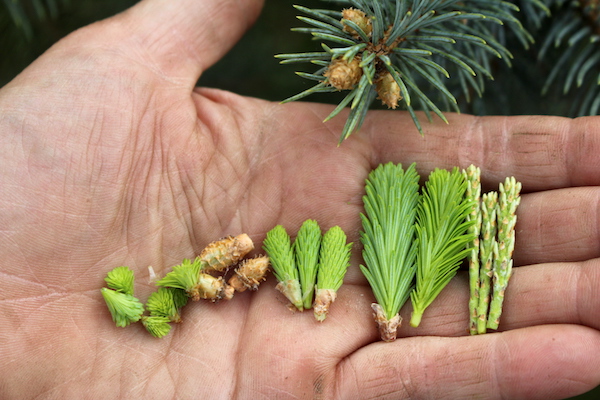
A spruce tip is the new spring growth at the end of a branch. The tree hunkers down for winter, but then in the spring, they send out tender (and flavorful) new growth. The flavors can vary from tree to tree, ranging from bright and citrus-y to warm and resinous.
While spruce are the most famous, other conifer tips are also edible.
Identifying Conifer Species
We don’t have many spruces on our land, but we have a plethora of hemlock, pine and fir trees. I’d had my eye on making spruce beer for years, but without a source of spruce tips, it seemed out of reach.
A few months ago, when I was doing research for an article on how to eat a pine tree, I learned that all conifer tips are edible with the exception of yew trees which are questionably toxic. That’s a pretty big selection of conifer tips and a lot more options than spruce tips alone.
I found a really excellent guide to identifying different conifer species here, and it takes you through all the ins and outs of different varieties. I’ll give you a quick rundown of each species as I know it.
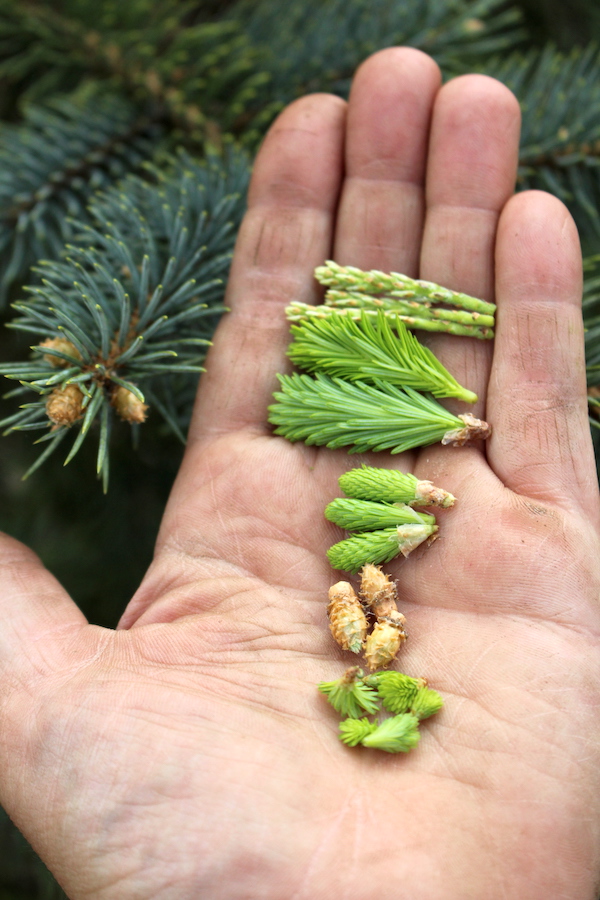
Spruce Tips
As it turns out, we do have a spruce or two in a few landscape plantings around our house. Spruce tips tend to stay inside a papery covering when they’re young, which helps you identify them at a distance.
Beyond that, spruce trees:
- Tend to have short and stiff needles, that feel a lot sharper than the other conifers.
- Each needle comes out of a single small woody projection (instead of in groups like pine needles) and if you pull out a needle the woody projection remains (unlike needles on fir trees which come off clean)
- Needles are square in cross-section, and they can be rolled between the fingertips.
Spruce tips are the canonical “tip” that’s used by fancy chefs to create real world-class foraged food. This spruce tip ice cream is served in classy restaurants, and they’re also used as an exotic veggie mixed with pasta or in stir-fries.
Still though, my favorite are fir tips…
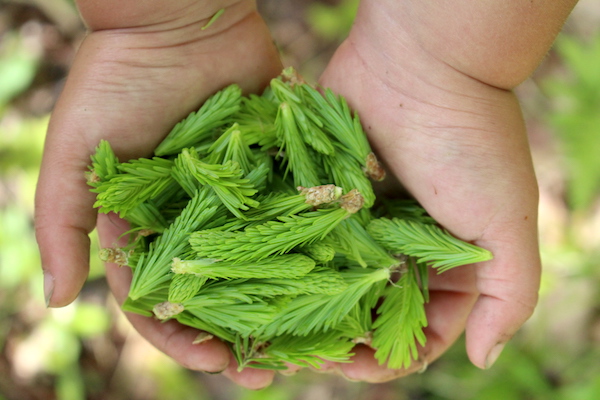
Fir Tips
My favorite thus far, all the fir tips around these parts are lightly sweet with a hint of citrus. Grapefruit maybe, with an ever so slight bitter note. They’re also a lot more pleasant to harvest than spruce tips since the needles are soft and you won’t get spiked if you trip into the tree.
Fir trees have:
- Soft, flat needles.
- Needles grow individually from the branch (unlike pine) but they’re attached with what looks like a tiny suction cup (rather than a woody projection like spruce).
- a white-ish color on the undersides of the needles.
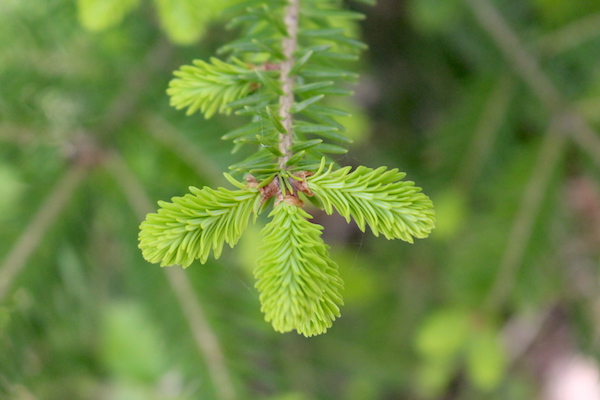
Thus far, I’ve been eating fir tips raw out of hand because they’re so good. I have a boatload of them squirreled away in the fridge, and I’m hoping to get creative over the next month or so. Tips keep really well if they’re refrigerated promptly, so these will be coming out for fun projects all the way into mid-summer.
I did make a lovely fir tip posset, which is a simple eggless custard that simmers cream until it thickens and then adds a bit of lemon juice to help it set up. If you summer the spruce tips in the cream, they infuse beautifully.
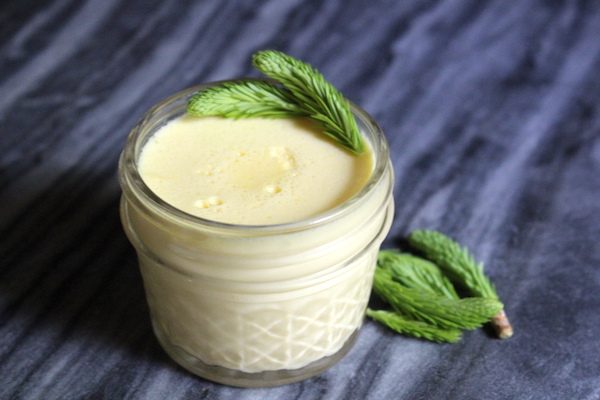
Pine Shoots
Probably the easiest to identify of all the conifers, pine trees have many long needles coming out of a single point of origin. Beyond that, pine trees have:
- Upturned branches that tend to grow sparsely in comparison to other conifers.
- They grow in whirls circling the trunk, and the tree puts out a new ring of branches each year (handy for approximating the age of a pine tree).
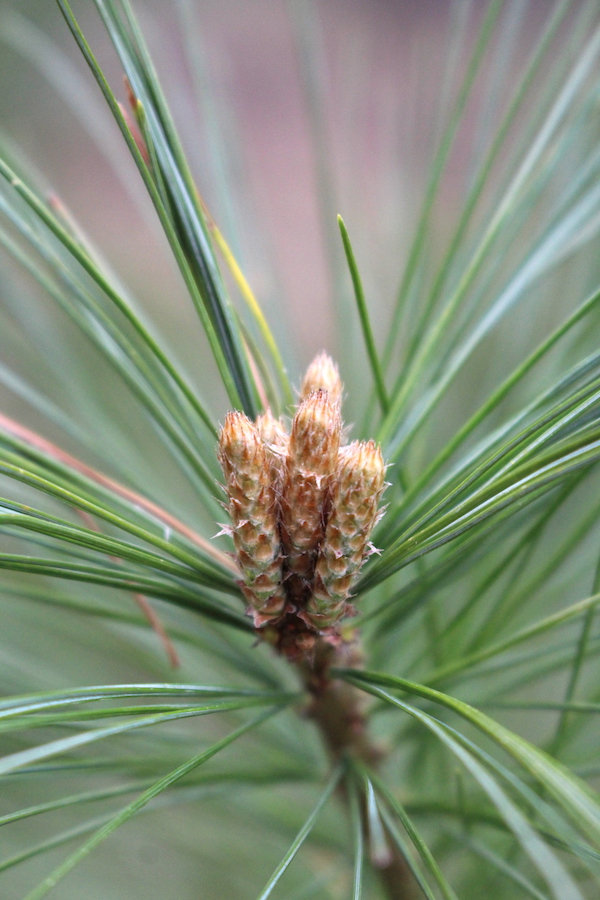
Pine shoots are a bit different than all the other “tips” in that they’re more of a tight shoot and they don’t really look like conifer needles. It’s the shoot of a new branch coming out, and there are no needles visible yet. They’re pretty plain-looking, but they’re packed with incredible flavor.
Warm, spicy and resinous, pine tips taste like sweet pine candy to my palate. Imagine the smell of pine, but without the “green” taste of the needles (if you’ve ever recreationally eaten pine needles). Slightly bitter, but still warm, comforting and mildly sweet.
I made a pine shoot syrup that’s totally out of this world, and just uses sugar to draw out the natural liquid from the pine shoots. Add in 2 parts pine shoots and 1 part sugar to a jar, then give it a good shake. Allow it to sit for about a week, shaking it any time you think about it, and then spoon out a taste of heaven.
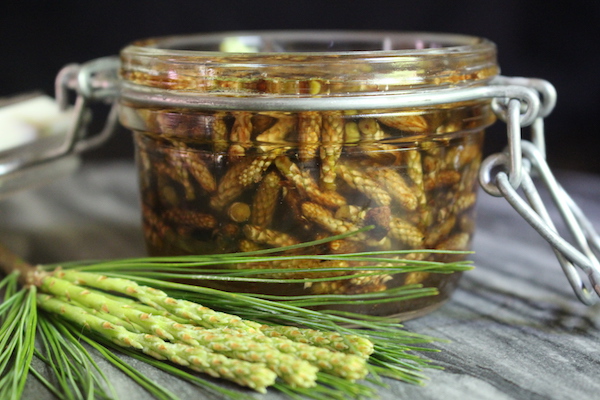
I dipped a spoon in for a taste, and I’m glad I was alone because I actually let out a soft moan…so good! Next year I’m making a huge batch of this stuff.
This pine shoot syrup can be used to flavor meats, and I’m thinking it’d make a really unique baklava-like treat. It’s also a natural cough syrup, in the same way as this pine needle cough syrup.
Hemlock Tips
Thus far I’m not a huge fan of hemlock tips. They’re wicked tiny, and they taste distinctly sour to my palate. Hemlock trees have needles that are flat and come out in one plane from the stem like a fan.
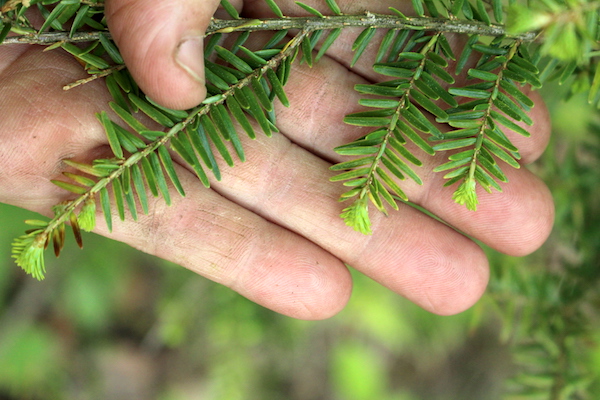
They can look a bit like yew species, but the underside of hemlock needles are white, while yew are a uniform green.
While I’m passing on hemlock tips, I am loving baby hemlock cones. The underside of mature trees produce tiny hemlock cones that you can harvest at the same time as tips. They’re sweet and flavorful, and much better tasting than the tips.
A little later on they produce a lot of pollen from those little proto-cones, and I’m trying to come up with some way to gather it. Give the branch a whack and you’ll see what I mean, as a huge cloud puffs off the branch if your timing is right.
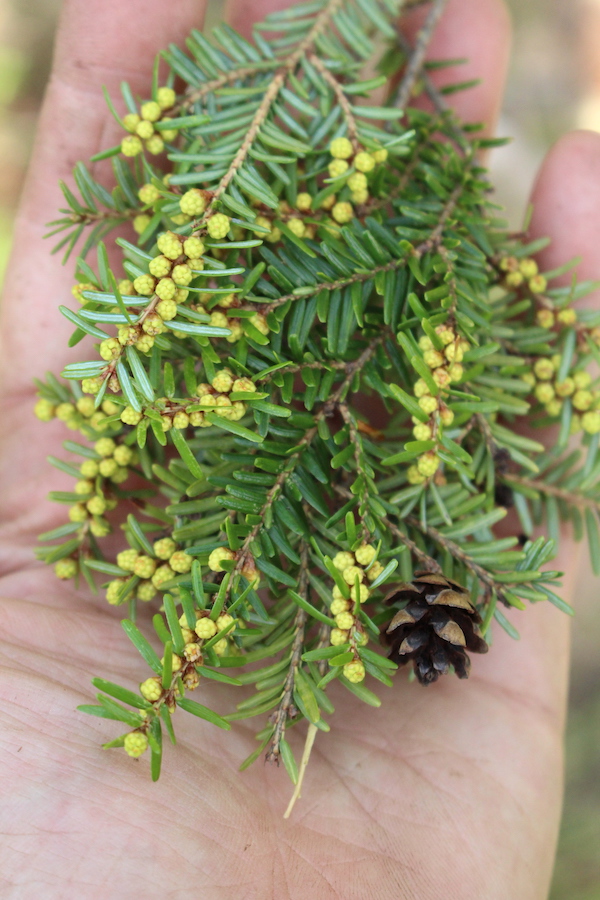
Avoiding Toxic Species
While most conifer tips are edible, there are a few to watch out for. As always, do your own research and don’t just take my word for it. I don’t know every single species worldwide, and there’s the potential that some are problematic and I’ve just never heard of them.
Here are the ones I know to be potentially toxic, but I’d suggest positively IDing any species you intend to eat and making sure it doesn’t cause issues in humans.
Yew Species
All yew species are toxic, and they can look a bit like hemlock if you’re not careful. Your best bet in avoiding a potentially toxic yew tree is to positively ID the conifer as something else edible. Pretty simple.
In the northeast, we do have some yew species, namely Taxus canadensis, which looks quite a bit like young hemlock trees. The main difference is hemlock trees have a white underside, and this species of yew is evenly green on both sides.
I’ve never seen a yew tree to my knowledge out here, and I think they’re maybe more common in the Pacific Northwest. You can see I’m no expert on these, so do a bit of research to see if there are any in your local area to avoid.
Cedar
Cedar is generally considered not edible, though I have heard of some traditional ways to use it (and it’s commonly used as a medicinal tree species in various preparations). Don’t use any cedar species.
Ponderosa Pine
Out west there is a potentially problematic species known as ponderosa pine. I’d recommend you do your own research on this one, as it’s questionably toxic.
Eaten in large quantities, it causes abortion in cows and other complications. I’ve read plenty that says that’s a problem specific to cows, but still, I’d definitely avoid it if pregnant.
I don’t have access to this species, and I’m in no way an expert on it, I’d suggest you do your own research and use your best judgment.
Spruce Tip Recipes
Regardless of the type of tips you’re harvesting, search for “spruce tip recipes” because that’s the one that everyone knows. Each conifer tip has a slightly different flavor, but so does each individual tree. They all produce slightly different flavors, so if you find one you don’t like, that doesn’t mean the next tree might not be better.
- Spruce Tip Syrup ~ Honest Food
- Fiddlehead Salad with Spruce Tips, Peppermint, and Pecorino ~ Forager Chef
- Pickled Spruce Tips ~ Forager Chef
What’s your favorite way to use spruce tips? I’m always looking for new ideas! Leave me a note in the comments.
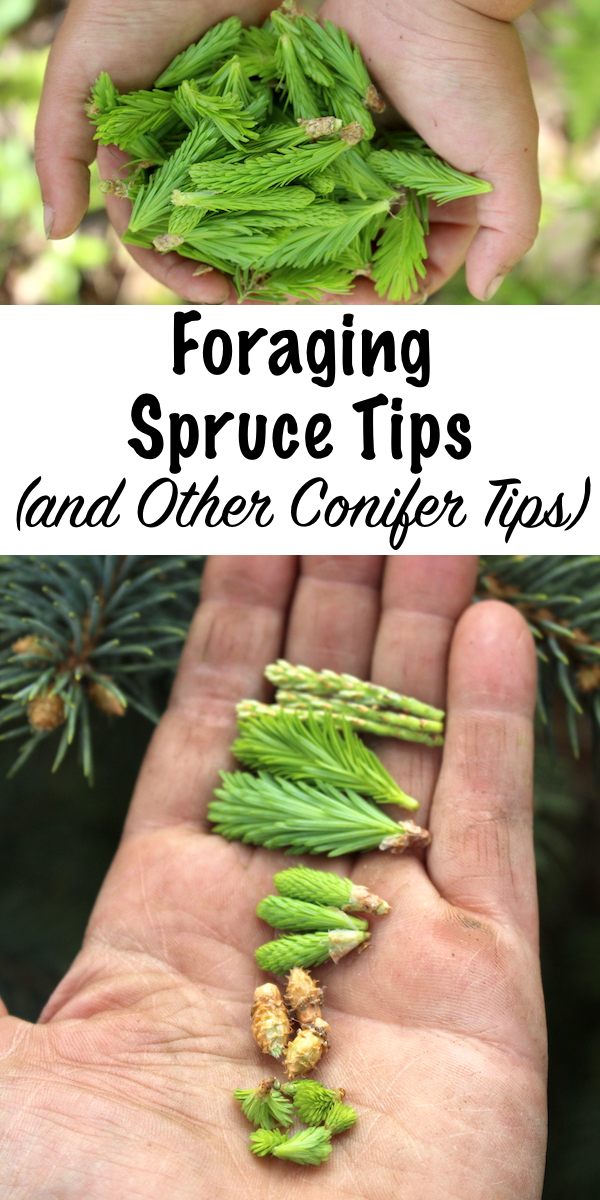


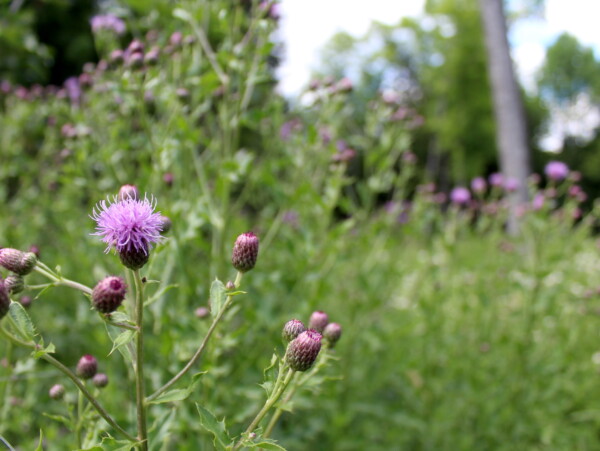
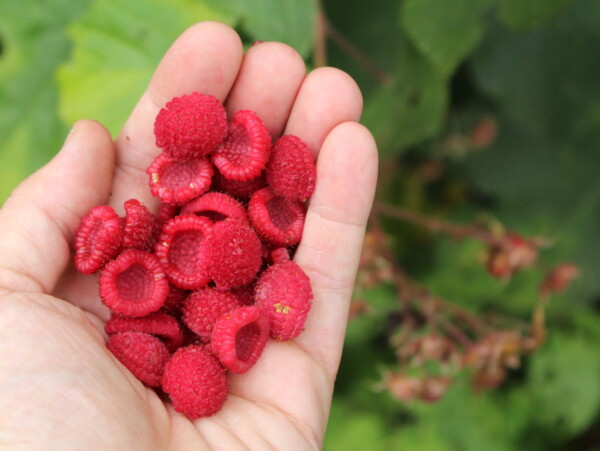
I had fir tips for the first time this year and I’m OBSESSED! The ones in my yard have a bright citrusy flavor that’s slightly sour and back end taste of that Christmas tree smell. I’m so excited that I have to prune the low hanging branches anyway, because that means I can harvest all of them so they don’t go to waste. I’ve wanted to try them in a tea, but they’re so delicious that they never make it indoors!
The tea is definitely milder than eating them fresh and if yours are that darn good fresh then that’s probably the best way to enjoy them, since you get the most flavor out of them like that. (Other than maybe spruce tip ice cream, which is unbelievable.)
Just a note that you will often see Yew (Taxus canadensis) aka, Canada yew or Eastern Yew, being referred to as Creeping Hemlock or Ground-Hemlock. Which is confusing because you will see Hemlock sometimes referred to as Canadian Hemlock or Eastern Hemlock.
It can definitely be confusing which is why scientific names can be so helpful.